Communism fell in Eastern Europe and Germany in 1989-1990. The road to that in East Germany began decades earlier, even before the building of the Berlin Wall in 1961.
In 1953, only eight years after the end of WWII, people in eastern Germany rose up against the German Socialist Unity party (the German acronym is “SED”) and their Soviet masters.
The protests ended with hundreds dead, a huge public relations loss for the USSR, lingering resentment against the government, and the birth of a national holiday in West Germany that continued until 1990.

It is hard to imagine now, at a time when Germany is one of the world’s richest countries, but eight years after WWII, the nation was re-building.
Virtually every major city in the nation had been flattened in the bombings during the war, and though life was tough in the western part of the country, life in the east was worse.

Making matters worse was the fact that the Soviets demanded reparations on a massive scale for the damage done by the German invasion during the war. Most of the remaining gold wealth, industrial plant, crops and much else was carted up, put on trains and sent to Moscow.
Electricity was scarce, and generally turned off nationwide at night. Consumer goods other than food (and that was scarce) were virtually non-existent.

Compounding the problem was the issue of mass emigration. Emigration was so common that it had a nickname: “Republikflucht” – “flight from the Republic.” Though emigration would not reach critical mass until 1960-61, many of the most skilled workers and intelligentsia left the country for West Germany.
After the war, there was a sort of political and economic paralysis until the reins of government were firmly seized by a Soviet henchman and longtime communist Walter Ulbricht, who under orders from Stalin, began to implement Soviet economic policies on the nation.
Top 10 Surviving Buildings Built By The Nazis During Their Time In Power
As had happened in the Soviet Union in the years after the Bolshevik Revolution and the 1930s under Stalin, private property was virtually wiped out. The middle-class and small private tradesmen were taxed almost completely out of existence and most farms were collectivized.
During the Nazi years, Hitler had outlawed labor unions. In the years immediately following the war, some East German industrial workers had formed unions, but now they too were made illegal, unless they were part of the governments officially sanctioned union.
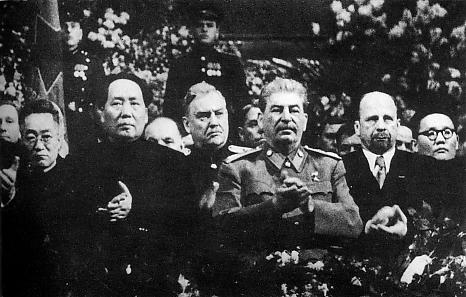
Before the Nazi era, the church, both Catholic and Protestant, sponsored youth and community groups. Other youth groups also had a long tradition in Germany. Under Hitler, these were either banned or were forcibly integrated into the Nazi Party.
In the power vacuum that existed after the war, many of these groups began again, offering community help to those in need and a sense of belonging in a country destroyed by war. In late spring of 1953, the government moved to suppress these organizations, causing widespread resentment.

All of these factors on their own were almost enough to get the public out into the streets in protest, but not quite. The last straws were orders from Ulbricht to crackdown on labor organizations and to enforce new economic rules.
These rules hit the East German people hard. Among them were higher taxes, higher prices, and worst of all, an order to increase production quotas – without any increase in pay. Actually, not only was there no raise for more work, but workers who did not meet the new quotas would be penalized with pay cuts.
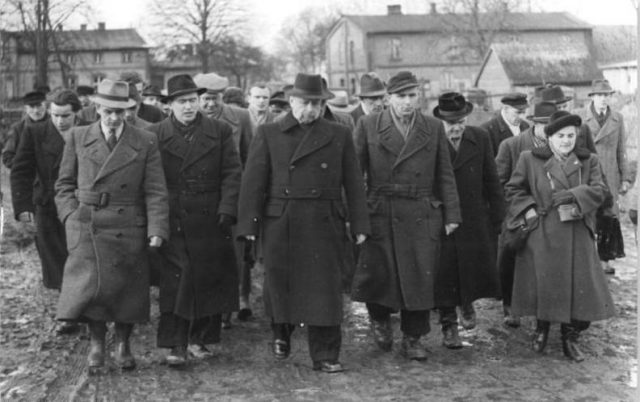
In March 1953, Joseph Stalin died and there was confusion in the U.S.S.R. as to who would rule in his place. In East Germany, this meant that Ulbricht and the SED faced the question about how to continue – follow Stalin’s directives or wait and do nothing until instructions from Moscow were forthcoming.
They decided the best course of action was to continue the crackdown and get the country firmly under their control.
On June 16th, a few hundred workers gathered in eastern Berlin in protest against the pay-cuts/quota scheme. They first marched to the East German Trade Union building where the government-sponsored unions had their headquarters.
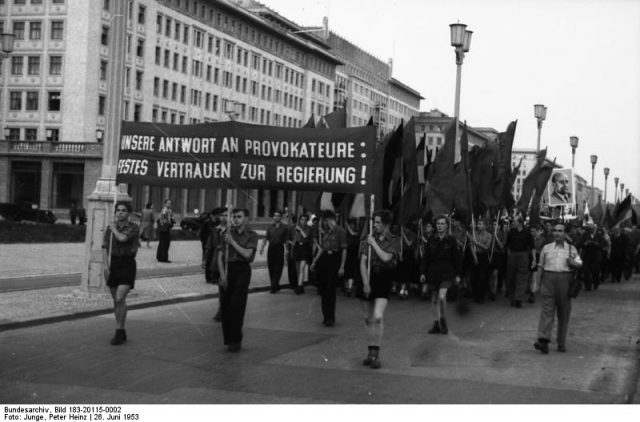
Demanding answers about the new policies, the crowd soon swelled to a couple thousand, then ten thousand. Not getting the answers they were looking for, the crowd then marched to the main government buildings in nearby.
By the time they arrived there in the afternoon, many in the crowd had made banners reading “Unity is Strength,” “Workers Join Us!”, “We want freedom, not slavery!” and perhaps most alarming to the authorities, “We want free elections!” – this last was not about work, but about politics and who ruled the country.

The crowd had grown to number perhaps twenty-thousand when an official from the government addressed the crowd, and told them to go home because their demands to eliminate quotas had been met.
Many were skeptical in the extreme and called for a general strike the next day. News of the demonstrations had filtered to the West and been broadcast publicly. Adding to the governments’ trouble, many of the organizers of the demonstrations were members of the official government union who were sympathetic to the workers in the streets. These last two factors greatly embarrassed the government, almost ensuring a crackdown.
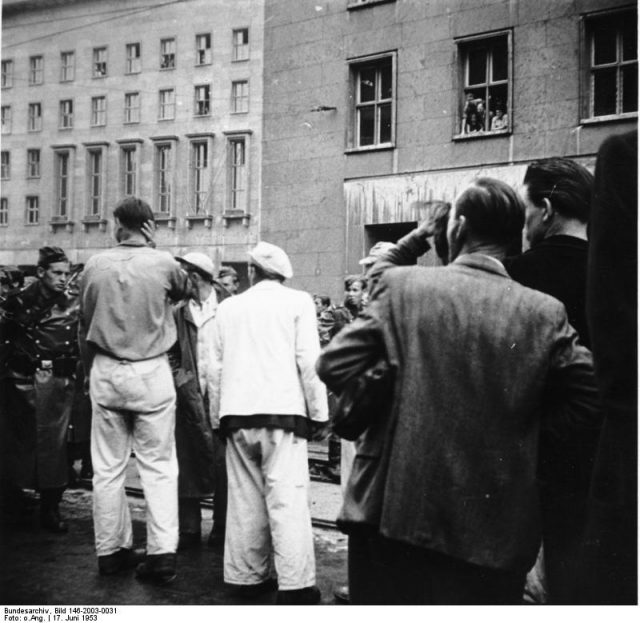
By the next day, workers all over East Germany had heard the news on radio reports from the BBC and the U.S. Information Agency. Now, instead of a localized problem, the government faced a nation-wide protest.
By midday on June 17th, the demonstrators had ceased calling for better working conditions/pay and were now calling for the resignation of the government. All of the resentments heating up since the end of WWII began to boil over.

The absolute last thing the Soviet Union was going to tolerate was an independent non-communist East Germany. WWII had not been fought so that a unified Germany could align itself completely with the United States and Great Britain. The Soviet and Eastern German leadership were in agreement – the protests would be put down by force.
In the late afternoon/evening of the 17th and into the morning of the 18th, twenty-thousand of the hundreds of thousands of Soviet troops in the country spread out in Berlin and other major cities.
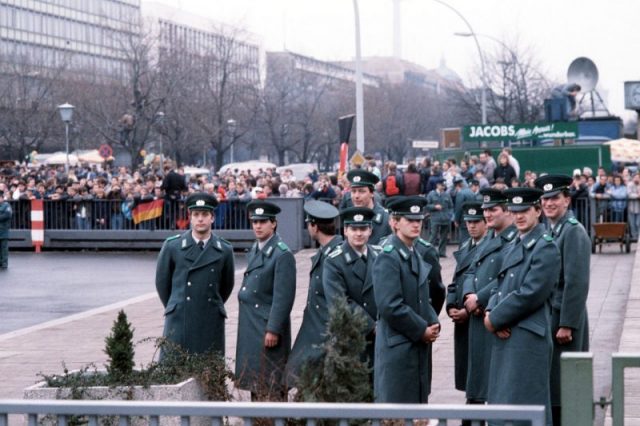
They were joined by thousands of East German militia/police (the “Volkspolizei” or “People’s Police”). On the Potsdamer Platz, one of the main streets of eastern Berlin, the Soviets opened fire – with tanks and machine guns. Witnesses reported seeing rows of people falling “like wheat against a scythe” as they died in protest.
Official estimates put the dead at over 500, with about 100 SED members killed by protesters. 106 accused “ringleaders” were convicted of treason and executed. Over five thousand others were sent to “re-education” camps – labor camps.
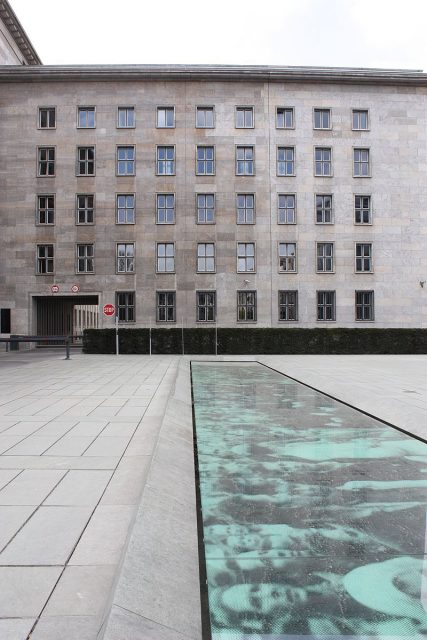
Reportedly a number of Red Army soldiers were executed for not carrying out their orders to open fire. In the years since the fall of the Berlin Wall, estimates of the number of dead have increased to a probable 1,000 or more people.
Read another story from us: The Internment of Ukrainian Canadians During the First World War
East Germany went on to become one of the most hard-line of the U.S.S.R.’s European satellites. Shortly thereafter, the West German government made June 17th the national holiday. This was changed to October 3rd after reunification, but June 17th is still an official memorial day in Germany today.
Matthew Gaskill holds an MA in European History and writes on a variety of topics from the Medieval World to WWII to genealogy and more. A former educator, he values curiosity and diligent research. He is the author of many best-selling Kindle works on Amazon.
